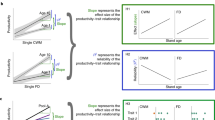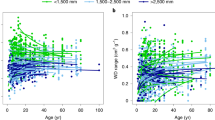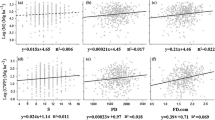Forest inventory data was used to examine the relationship between successional diversity and forest ecosytem function. The inventory data show that stands composed of early successional species are more productive than stands composed of late successional species, whereas stands composed of late successsional species have lower turnover than stands composed of early successional species. Taken alone, these results would suggest that forests should be managed in a way that favors the most productive early successional species or longest-lived late successional species, depending on whether the goal is to maximize productivity or maximize carbon storage. However, the inventory data also show that stands with low successional diversity fix and store less carbon than stands with high successional diversity. This result suggests that forests should be managed in such a way as to retain species diversity while also favoring species that maximize the ecosystem function of interest.
Similar content being viewed by others
References
Binkley C. S. (1980) Is succession in hardwood forests a stationary Markov process? Forest Science 26: 566–570.
Birdsey R. & Schreuder H. (1992) An overview of forest inventory and analysis estimation procedures in the eastern United States – with emphasis on the components of change. General Technical Report RM-214. USDA Forest Service, Rocky Mountain Forest and Range Experiment Station, Fort Collins, CO.
Caspersen J., Pacala S., Jenkins J., Hurtt G., Moorcroft P. & Birdsey R. (2000) Contributions of land-use history to carbon accumulation in U.S. forests. Science 292: 2316–2320.
Hansen M., Frieswyk T., Glover J. & Kelly J. (1992) The eastwide forest inventory database: User’s manual. General Technical Report NC-151. USDA Forest Service, North Central Experiment Station, St Paul, MN.
Hooper D. & Vitousek P. (1997) The effects of plant composition and diversity on nutrient cycling. Ecological Monographs 68: 121–149.
Horn H. S. (1974) The ecology of secondary succession.◊Annual Review of Ecology and Systematics 5: 25–37.
Horn H. S. (1975) Markovian properties of forest succession. In: Ecology and Evolution of Communities. (eds M. Cody & J. Diamond) pp. 196–211. Belknap, Cambridge, MA.
Kinzig A., Tilman D. & Pacala S. (In press) Biodiversity and Ecosystem Function. Princeton University Press, Princeton, NJ.
Schroeder P., Brown S., Mo J., Birdsey R. & Cieszewski C. (1997) Biomass estimation for temperate broadleaf forests of the United States using inventory data. Forest Science 43: 424– 434.
Tilman D., Knops J., Wedin D., Reich P., Ritchie M. & Sieman E. (1997) The influence of functional diversity and composition on ecosystem processes. Science 227: 1300–1302.
Van Hulst R. (1979) On the dynamics of vegetation: Markov chains as models of succession. Vegetatio 40: 3–14.
Author information
Authors and Affiliations
Corresponding author
About this article
Cite this article
Caspersen, J., Pacala, S. Successional diversity and forest ecosystem function. Ecol Res 16, 895–903 (2001). https://doi.org/10.1046/j.1440-1703.2001.00455.x
Accepted:
Issue Date:
DOI: https://doi.org/10.1046/j.1440-1703.2001.00455.x




